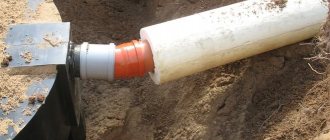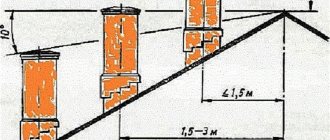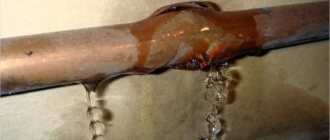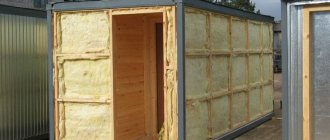How to insulate a water well: 3 main methods
Only wells that are located inside the house do not need insulation. If the water source is located outside, it must be protected for the winter. Frozen water increases in volume. Ice formation leads to pipeline ruptures and equipment breakdowns.
To prevent this from happening, you need to insulate the water supply system. Insulation for the winter can be done in three different ways:
- Use of thermal insulation materials.
- Laying the heating wire.
- Installation of plastic caissons.
Most insulation consists of synthetic fibers. Some of the materials have a porous structure that contains air cells. Other materials consist of fibers that are separated by air spaces. Air cavities prevent heat loss.
Using a heating cable allows you to heat the water supply, rather than reduce heat loss. We recommend laying self-regulating wires. They change the heating intensity depending on the ambient temperature. This solution saves electricity consumption.
Plastic caissons for wells provide protection for equipment from freezing. Polymer materials have a low thermal conductivity coefficient. To reduce heat loss, an insulating cap is placed on the neck of the tank.
Figure 1: Visual: the design of a plastic caisson with an insulating cover.
How to insulate a well and water supply system for the winter with your own hands ↑
Working with modern materials is very easy
Place a special insulating material on the pipes: Merylon, shell (foam plastic), basalt fiber. They have the shape of a pipe and vary in diameter.
The installation method in this case consists of threading the pipes into the insulation tubes. Fasten the heating cable to the pipe. It independently regulates the temperature and heats up if necessary, which will prevent the water in the pipe from freezing. It will need to be strengthened to the surface and covered with a layer of insulation or waterproofing. Use a ready-made insulated pipe.
It consists of two pipes that differ in diameter, and insulation is laid in the internal distance between them, usually having a fibrous structure: fiberglass, basalt. The space can also be filled with polyurethane foam. Sometimes a heating cable is attached to the inner pipe.
Polystyrene foam can completely block the access of cold to the pipe
Make an insulated pipe with your own hands.
To do this, thread a water pipe into a large pipe. Push insulation (glass wool, basalt) tightly into the space between them. The disadvantage of this option is the possibility of voids forming or uneven laying of the insulation.
This, of course, is not a complete list of options for how to insulate a pipe; we have presented only the most common ones. Each owner can come up with others or get creative and combine the above.
It is worth noting another well-known method, which has become quite widespread due to its availability - sheets of foam plastic are laid over the water pipe running from the well to the house, because foam has high thermal insulation properties. The sheets are simply laid over the trench and covered with soil.
The main function of the caisson is thermal insulation
A caisson for a well is installed if the owners of the site plan to use water throughout the year. The main function of the caisson is to insulate the water well. A good caisson protects the wellhead and installed equipment from freezing.
Only a plastic caisson can provide insulation of a well. Plastic has a low thermal conductivity coefficient. Reservoirs made of metal or concrete rings retain heat less well. During installation, additional thermal insulation of the walls may be required.
The design of caissons from Aqualux+ includes an insulating cover and an insulating flange. A correctly installed caisson usually does not require additional thermal insulation. After purchasing a caisson, you will not have to think about how to insulate the well on the site.
Boudin is interested: Is it worth drilling a well in sand? Let's tell!.
We will calculate the cost of installing the caisson in 1 minute!
Click on the button and order a call back from the Aqualux+ manager.
Order
How to insulate the lid
Caissons "Aqualux+" are equipped with a special insulating cover. It prevents heat loss through the top hatch. Installing an insulating cover is the easiest option for insulating a well. A plastic hatch is placed over the insulating cover.
Choose a model with a protective cover so you don’t have to worry about how to properly insulate your hatch for the winter with your own hands. The insulating cap is put on the neck in a few seconds. It fits tightly to the walls, ensuring the tightness of the tank.
Buden is interested: How to equip a well without a caisson: summer and winter installation.
Figure 2: What an insulating cover looks like.
Sealing the casing entry
At the bottom of any caisson there is a sleeve for the casing. This is another point that needs to be sealed to prevent groundwater from entering inside the caisson. The entry point is sealed by welding or installing a rubber coupling. A rubber coupling is the best option for this.
The design of the Aqualux+ caissons includes a sealed flange for the sleeve with a rubber coupling. When the caisson is properly insulated, the temperature inside does not drop below zero. The water supply to a private home operates uninterruptedly even in severe frosts.
We will calculate the cost of insulating a well in 1 minute!
Click on the button and order a call back from the Aqualux+ manager.
Order a calculation
Figure 3: Sealed flange - a guarantee against water getting inside the caisson.
Basic methods of well insulation
Water in wells rarely freezes, because... structures are drilled to quite great depths. If the water supply is used only seasonally, it is better to preserve the well for the winter. And in private houses, where it is necessary to ensure uninterrupted water supply, the upper part of the pipe and the supply line to the house are insulated.
When considering options for how to insulate the upper part, it is better to choose a caisson for a well. It is installed below the soil freezing level. If the structure is sealed, then additional protective measures will not be required. You can also build an insulated box that will cover the head of the well. Equipment is also located here.
Advice. In areas with a warm climate, it is quite possible to get by with a protective box-house, but where there are severe frosts, it is better not to skimp on insulation and install a caisson.
Sometimes wells are thermally insulated using improvised means - sawdust, straw, etc. Such half measures only save you for a couple of years. Natural materials quickly rot and lose their heat-insulating properties. You will have to replace them very quickly, otherwise problems with water intake will arise. It makes sense to spend money on high-quality insulation, but ensure reliable protection of the source for many years.
Well insulation
Option #1: building a caisson from a barrel
How to insulate a well for the winter with your own hands? The most reasonable solution is to buy a ready-made insulated caisson of industrial production and entrust its installation to the specialists of the selling company. However, this is the most expensive option. If you want to save money but get an equally reliable design, you can make a caisson yourself.
You will need a plastic or metal barrel of 200-500 liters. You can take a used one if the walls are not damaged or corroded by rust, and the lid closes tightly.
As for the volume, you should choose based on the functions that the improvised caisson will perform. A 200-liter pump can accommodate a maximum pump, but a volume of 500 liters should be enough to install all the necessary equipment.
Diagram: caisson device
How to insulate a well on the street using a caisson:
- A pit is dug around the pipe to the level of soil freezing plus another 40 cm. The width of the trench should correspond to the size of the barrel plus another 50 cm. The bottom of the hole is covered with a 10-centimeter layer of sand and gravel mixture.
- Holes are cut in the container for the well head and water pipe. After this, the barrel is put on the well pipe and lowered.
- When the structure is installed, you can connect the water supply pipe and install a condensate drain pipe.
- For additional insulation of the caisson, foam plastic, mineral wool, and isolon are used. The heat insulator is mounted on the outside of the barrel and secured.
- A hole is cut in the lid of the barrel and a ventilation tube is installed. The lid itself is insulated with the same material as the walls.
- At the end of the work, the pit is filled with the excavated soil and compacted thoroughly. The caisson is ready for operation.
Installation of a caisson from a barrel
Option #2: arrangement of a box-house
To insulate a well, you can build a wooden, metal or brick box with your own hands. It is made in the form of a small house with a pitched roof to protect it from snow and rain. They are insulated from the inside - with polystyrene foam or mineral wool. The dimensions of the box must be such that all downhole equipment can freely fit in it.
Insulated box for the well head
Work order:
- The walls of the box are laid out from bricks, blocks or made of plywood.
- The surface of the walls is leveled, if necessary. The foam is mounted on an adhesive composition. Seams, gaps and joints are sealed with polyurethane foam.
- The insulation is covered with a sheet of chipboard and secured.
- The lid is made in the form of a pitched roof, insulated, and hung on hinges. If necessary, you can close the box with a padlock.
Well arrangement diagram
Option #3: use scrap materials
How to insulate a well in a region with a mild climate? If the temperature in winter does not drop below 15 degrees, and the owner of the well does not want to install a box, you can make do with sawdust, straw or dry leaves. The first option is preferable.
Sawdust as insulation
Insulating a well for the winter with your own hands:
- A pit is dug around the casing to a depth of 0.5 m below the freezing level of the soil. The width of the hole depends on the amount of materials with which it is planned to fill it.
- Dry insulation is laid in layers in the foundation pit and compacted.
- When the insulation layer is almost equal to the ground level, soil is poured on top and compacted thoroughly.
Advice. You can equip not just an insulating, but also a waterproofing pillow. To do this, sawdust is mixed with liquid clay. The resulting mixture is placed in a pit and covered with soil. Clay will additionally strengthen the soil around the hydraulic structure.
Diagram: water well design
Additional insulation options
It may be interesting: Rules for operating a water well.
If you have already installed a caisson without thermal insulation, you can insulate it yourself. The following insulation materials are suitable for thermal insulation:
- Expanded polystyrene, polystyrene foam, penoplex. Synthetic insulation materials that are similar in composition and contain up to 95% air. Insulation materials from this group are rigid and weakly absorb moisture.
- Penofol or polyethylene foam. Available in the form of cylinders and sheets. Suitable for insulating pipelines or underground chambers. Has poor compression resistance.
- Glass and mineral wool. These insulation materials absorb moisture very well, and when wet they lose their protective properties. Therefore, glass wool and mineral wool are rarely used for insulation of pipelines. These insulation materials can only be installed inside a protective box. Most often they are used for insulation of wells with caps.
- Foamed polyurethane foam and penoizol. To apply these compounds you need special sprayers. The liquid composition is prepared from two mixed components. When the liquid hardens, a porous substance with a large number of air cells is formed. The finished surface is soft and uneven, but it repels moisture well.
- Expanded clay. Lightweight porous stones produced by firing clay. Expanded clay is sometimes used to line caissons and trenches intended for water supply.
All of the methods listed do not provide an absolute guarantee of well protection, especially if you carry out thermal insulation yourself. The most reliable way to insulate a well on a site is to select and install a good caisson.
How to save money when constructing a well?
Click on the button and order a consultation with an Aqualux+ manager.
Find out savings
Methods of insulation depending on seasonality of operation
Options for how to insulate a well for the winter depend primarily on how often it is used. There are 3 main types of use and corresponding methods of thermal insulation:
- Seasonal.
Typical for a country house. This implies the preservation of the system for the winter and the complete absence of any thermal insulation. Before the onset of the first cold weather, the pipes are drained and the equipment is disconnected from the power supply. In this case, the pump is turned off and all taps are opened.
- Periodic.
The water intake operates all year round, but not constantly, but in periods, for example, every other day, on weekends or holidays, etc. In this case, in addition to passive thermal materials, active heating technologies are used - heating wire. Since a long absence of flow in the pipes will lead to their rapid cooling and icing with subsequent damage.
Summer well for home Source i2-ww.ru
- Permanent.
The movement of water in the pipes occurs constantly, with the exception of short periods of downtime - at night, during the day, when everyone is at work, etc. However, the icing process can begin during extreme cold snaps, and at the peak of the cold season, and with shallow communications, and superficial location of the pump and equipment. Therefore, the use of high-quality insulation with special materials is required.
Advice! Methods and means of insulation directly depend on the climatic characteristics of the region where the well is operated. If the temperature rarely drops below -12-15°C, communications need not be immersed in the ground to great depths, but sawdust, peat, expanded clay and other natural fillers can be used as thermal insulation materials. On the contrary, in places with more extreme climates, where temperature drops to -20-30°C and below are not uncommon, it is permissible to use only professional materials - polystyrene foam, penoizol, polyurethane foam, etc.
Insulating a well for the winter from the inside Source notperfect.ru
See also: Catalog of companies that specialize in water supply and sewerage
Thermal insulation of a caisson made of concrete rings
Caissons made from concrete rings are considered one of the worst. Concrete provides poor insulation compared to plastic. If you cannot replace the structure made of concrete rings, then it is worth additionally insulating it.
Insulation of concrete rings is carried out only from the outside. The insulation also performs the additional function of waterproofing. It protects concrete from the effects of groundwater. A hole is dug around the concrete well, which should be 50 cm deeper than the soil freezing line.
Concrete rings are cleared of soil and repaired if necessary. The concrete is covered with a layer of waterproofing. After this, insulation is attached to the outer walls of the rings: penoplex or polyurethane foam.
It is advisable to wrap the insulation with waterproofing film before filling the pit. A blind area should be laid out on the surface of the ground to drain rain and melt runoff from the mouth.
Figure 4: How to effectively insulate a leaking caisson made of concrete rings? The answer is no way!
Method of insulating a well with a head
If a well cap is installed on the well, the risk of equipment freezing increases. You can isolate a well with a head using a box. To assemble the box, you can use boards, mesh or rigid insulation.
The most reliable option: assemble a box from boards and line the inside with sheets of insulation. The volume of the box should not be less than one cubic meter. The finished box is put on the upper part of the casing and the well head.
The space inside the box is filled with mineral or glass wool. Filling the box with improvised materials is less reliable. But if you save your budget, you can use dry leaves, paper, hay and straw to fill the box.
How to insulate a water supply on a site
Water pipes located outside also need insulation for the winter. The depth of the trench should be greater than the depth of soil freezing in the region. In the Moscow region, water supply on the street is installed at a depth of 1.5-2.0 meters. The trench is filled with previously removed soil and sand. In most cases, this is enough for insulation.
Insulation is used if the pipes are not laid deeply, or the home owners want to provide additional protection for the water supply. Methods for insulating outdoor water pipes:
- Connecting a heating wire to heat the water supply.
- Laying second pipes with a large diameter, creating an air gap.
- Installation of a shell made of polystyrene foam or other insulation.
- Installation of a box with mineral wool or other insulation inside.
The simplest option for insulating a water well is to connect a heating cable. Using this method does not require a lot of time and money. In severe frosts and when the well is idle, it is enough to turn on the heating wire to avoid water freezing.
Figure 5: Trench for water supply.
Plastic caisson as the best way to insulate
If you place the well head and all pipe distribution below the soil freezing level, then you won’t have to worry about their insulation. At this depth, even in the most severe frosts, the water in the well will not freeze, since its temperature will always be above zero. To implement this task, you have to dig a pit around the wellbore to a depth of 2-2.5 meters and install a caisson. For absolute reliability, the walls of the caisson and its hatch cover are insulated with mineral wool material or foam plastic.
Insulation of a well using a plastic caisson installed in a dug pit around the casing to a depth of 2.5 meters
At extremely low temperatures in a caisson well, it is recommended to install an additional cover with insulation directly above the well to eliminate the possibility of water freezing in the pipes. Installation of this element is carried out in advance, since it is undesirable to open the hatch in severe frosts.
Why do you need a heating cable?
The heating cable is laid outside. You can lay it inside or outside the pipeline. The included electric cable prevents the pipes from icing up and heats the water. Heating wire can be wrapped around not only the pipeline, but also the caisson and the mouth with the tip.
Insulation on the street can be carried out with different types of electrical cables:
- resistive - supply heat with the same intensity;
- self-regulating - change the heating temperature.
The efficiency of self-regulating wires is higher because the intensity of heating of the sheath depends on the temperature of the water. By choosing this option, ineffective heat loss is reduced. In terms of price, self-regulating wires are not much more expensive than resistive wires. At the same time, they provide significant energy savings.
Typically, HDPE pipes are used to supply water to the house. The material has low thermal conductivity, so using the cable outside is less effective. When the wire is laid outside, it requires additional insulation. It protects the wire from exposure to groundwater and reduces excess heat loss.
How not to freeze the water supply at the dacha
You can do winter water supply at your dacha yourself in two ways:
- bury it so that it does not freeze (below the freezing depth);
- lay shallow, but with insulation and/or heating.
Insulating a water pipeline is an undertaking that requires not so much money as labor - digging trenches, laying pipes, wrapping them, throwing and compacting the soil, all this takes time and considerable effort. But the result is the availability of water in the house at any time of the year.
Laying pipes below freezing depth
This method is advisable to use if in winter the soil freezes no deeper than 170 cm. A trench is dug from a well or borehole, the bottom of which is 10-20 cm below this value. Sand (10-15 cm) is added to the bottom; the pipes are laid in a protective casing (corrugated sleeve), then covered with earth.
To avoid having to insulate the outdoor water supply in cold weather, it is better to do this in advance
This is the easiest way to make winter water supply at the dacha, but it is not the best, although it is the cheapest. Its main drawback is that if repairs are necessary, you will have to dig again, and to the full depth. And since it is difficult to determine the location of a leak with this method of laying a water pipeline, there will be a lot of work.
To ensure that there are as few repairs as possible, there should be as few pipe connections as possible. Ideally, there should be none at all. If the distance from the water source to the dacha is greater, make connections carefully, achieving perfect tightness. It is the joints that leak most often.
Choosing a material for pipes in this case is not the easiest task. On one side, a solid mass presses from above, so a strong material is needed, and this is steel. But steel laid in the ground will actively corrode, especially if the groundwater is high. The problem can be solved by properly priming and painting the entire surface of the pipes. Moreover, it is advisable to use thick-walled ones - they will last longer.
The second option is polymer or metal-polymer pipes. They are not subject to corrosion, but they need to be protected from pressure - placed in a protective corrugated sleeve.
Even if the ditch was dug below the freezing level, it is still better to insulate the pipes
One more thing. The depth of soil freezing in the region is determined over the past 10 years - its average indicators are calculated. But firstly, very cold winters with little snow occur periodically, and the ground freezes deeper. Secondly, this value is the average for the region and does not take into account the conditions of the site. Perhaps it is on your piece that freezing may be greater. All this means that when laying pipes, it is still better to insulate them, lay sheets of polystyrene foam or expanded polystyrene on top, as in the photo on the right, or lay them in thermal insulation, as on the left.
You might be interested in reading “How to make automatic watering“.
Pipeline insulation
When supplying water to a private house from a well and a borehole, the pipeline can be laid at a very shallow depth - 40-50 cm - this is quite enough. Just laying pipes in such a shallow trench needs to be insulated. If you want to do everything thoroughly, then line the bottom and sides of the trench with some kind of building material - bricks or building blocks. Everything is covered with slabs on top.
An example of laying pipes above the freezing depth in a prepared ditch. The insulation of the water supply is carried out with a special insulation, with a suitable internal diameter
If desired, you can fill in the soil and plant annuals - if necessary, the soil can be easily removed and free access to the pipeline is provided.
Insulation for water pipes
Two types of insulation can be used:
- special energy-saving shells molded in the form of pipes, they are also called “pipe shells”;
- roll material - ordinary insulation in the form of rolls, which is used for walls, roofing, etc.
Thermal insulation for pipes in the form of a shell is made from the following materials:
- Expanded polystyrene - multiple granules are fused together. The result is a fairly rigid and durable material with good thermal insulation characteristics.
- Extruded polystyrene foam - the cells of the material have a closed structure (small balls). This also gives the material water-repellent properties, as well as higher thermal insulation properties. This is one of the best materials with a high degree of insulation, but its disadvantage is its high price.
- Polystyrene foam - one of the variants of expanded polystyrene - has good thermal insulation characteristics, but is characterized by low strength. That's why he needs protection - he can't stand pressure. But it costs a little. If you are laying pipes in a trench with walls made of brick or concrete, it is quite possible to use it. Nobody bothers you to play it safe and use two layers of insulation
- Polyurethane foam - in terms of characteristics and price, it is between expanded polystyrene and polystyrene foam. This is what is most often used for pipe insulation.
- Foamed polyethylene (such as “Energoflex”) has good characteristics due to the high content of air bubbles.
- Glass wool is a rolled material with good thermal insulation characteristics and a relatively low price. Its disadvantage is that it requires special measures when installing: fiberglass is very prickly, and it is impossible to remove microscopic particles from the skin. You also need a respirator and safety glasses - small particles are volatile and harmful to health.
- Stone wool. It is made from basalt or slag. Basalt wool has the best characteristics, but is expensive. Slag wool is a cheaper material, but its characteristics are worse - you need to take it in greater thickness, which often reduces material benefits to a minimum.
Insulation of water supply pipes in a private house is done using thermal insulation
Mineral wool - glass wool and stone wool - have one significant drawback: they are hygroscopic. By absorbing water they lose most of their thermal insulation properties. After drying, they are only partially restored. And another very unpleasant moment is that if wet mineral wool freezes, after freezing it turns into dust. To prevent this from happening, these materials require careful waterproofing. If you cannot guarantee the absence of moisture, it is better to use another material.
Heating cable installation technology
To insulate pipes, it is not necessary to wrap them entirely with wires. It is enough to lay a section a few meters long to heat the pipeline for the winter. In most cases, installation is carried out inside the water supply.
High-quality heating electric cables are supplied complete with thermostats. Many manufacturers include three-inlet fittings. To connect the electrical cable, a ½-inch entry and a rubber sealing gland are also required.
How to properly insulate a water supply from the inside:
- Assembling a tee from two pipes and an outlet for an electrical cable.
- Assembling the input unit for the electrical cable. The parts are fastened with FUM tape.
- Passing the wire through the gland to the selected length.
- Securing the wire at the input with a clamping sleeve.
- Installing a tee together with an electrical cable on the pipeline.
- Connecting the heating wire to the outlet via an extension cord.
Using an electric cable makes it possible to heat water. Other insulation methods slow down the freezing time. The insulation scheme with electric cable works effectively even in severe frosts.











